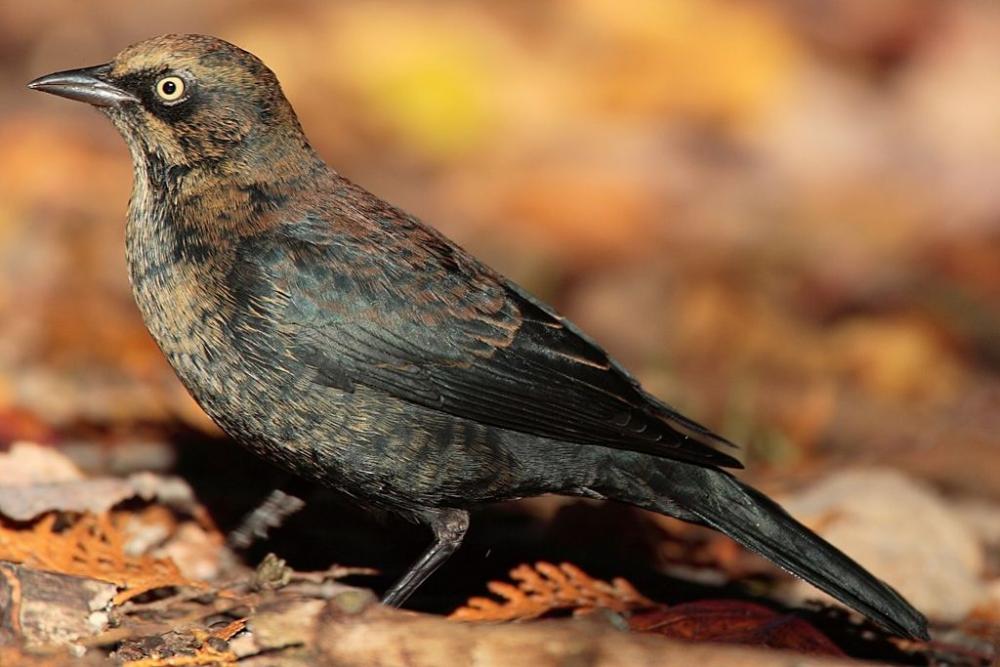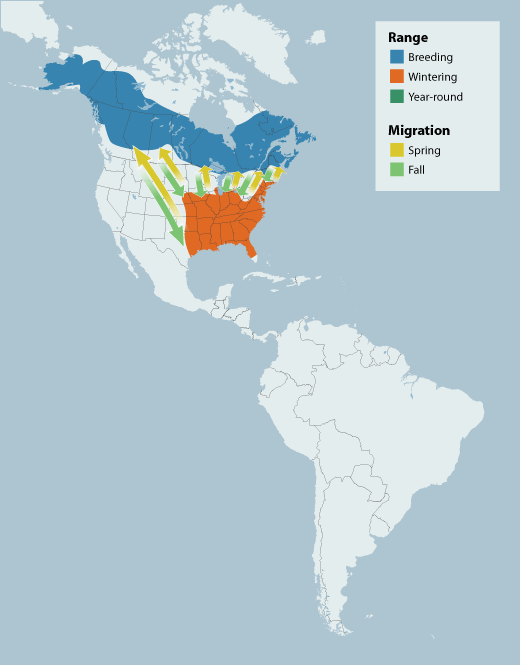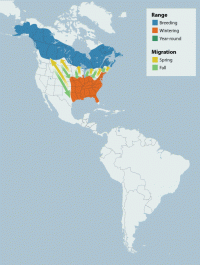Guide to Boreal Birds
This is an in-depth boreal species profile.
What is this?
This species is one of more than 30 birds selected for in-depth profiles. Find out why and see all selected boreal birds »
Overview
Blackbirds in general are among North America's most familiar – and least appreciated – birds, but the Rusty Blackbird is the "white sheep" of the family. It is without doubt the least well known, due to its relatively low numbers, remote breeding range, and minimal pest status. It was named for its winter plumage, in which it is most often encountered. Many aspects of its ecology remain unstudied and its population status is largely unknown. It is sometimes considered a keystone species because its sturdy nests often are used by other species.
Description
9" (23 cm). In spring males are black, with a bluish and greenish iridescence; females are dark gray. In fall they are much more rust-brown, especially head, breast, and back. Conspicuous pale yellow eyes in both sexes.
Voice
Like the squeaks of a rusty gate; call note a sharp check.
Nesting
4 or 5 blue-green eggs, with brown blotches, in a bulky stick nest lined with grass, moss, and lichens set in a dense shrub or low tree near or over water.
Habitat
During all seasons, the Rusty Blackbird is more of a forest and woodland species than other blackbirds. On the breeding grounds, it prefers wet areas such as fens, bogs, muskeg, ponds, and shorelines in coniferous and mixed forests. It responds favorably to disturbances such as limited logging, small fires, windstorms, and beaver activity that create openings and promote growth of saplings. During the remainder of the year it forages in fields and pastures, often with other blackbirds, while roosting in wet, wooded areas not typically used by other blackbirds.
Range/Migration
The Rusty Blackbird is primarily a diurnal migrant. Fall migration begins in September. This species travels in mixed flocks with other blackbirds, robins, and jays but also in pure Rusty flocks of up to 1,000 individuals that often appear after resident blackbirds have departed and do not linger long. Evidence suggests that there is no age or sex segregation in migrant flocks. Birds reach the wintering grounds, which extend from South Dakota and Massachusetts south to Texas and Florida, in the southeastern states in October. Some birds from the western part of the breeding range may cross the Great Basin and winter in blackbird flocks in the Southwest. Northward migration begins in March, the first birds arriving on the breeding grounds in April and the last in May.
Breeding
The majority of Rusty Blackbirds are boreal breeders, occupying the whole of the coniferous and mixed forest zone from the northern edge of deciduous forest and grassland to the southern edge of tundra. An estimated 70% of the species' population breeds in Canada's boreal forests. It nests in loose colonies, the pairs forming after arrival on the breeding grounds. Males display to prospective mates with tail fanned and bill open and making squeaking notes. The female builds a large nest of twigs, grasses, and lichen lined with grass and plant fibers in a tree, shrub, or stump near water and lays 3-6 eggs. These hatch in two weeks, during which the male provides food. The young fledge about two weeks later and may remain with the parents another month. Only one brood is attempted each year. Rusty Blackbirds do not reuse their own nests but Solitary Sandpipers frequently nest in Rusty Blackbird nests from the previous year.
Diet/Feeding Behavior
Like other members of its family, the Rusty Blackbird is an opportunistic omnivore. Its summer diet is predominantly wetland insects, supplemented by other insects, snails, crayfish, salamanders, and small fish. It displays a wide variety of foraging methods. It often searches for its prey along shorelines, much like a sandpiper, often wading, probing in soft sediments, and sometimes even plunging its entire head under water. It also excavates rotten wood and overturns debris to find insect larvae. It frequently uses its strong bill as a wedge to loosen mud and soil. During migration, when it feeds mostly in fields, it eats a variety of grains and weed seeds along with grasshoppers and small fruits. In winter it eats acorn mast, pine seeds, some fruit, and relatively little animal matter, though during particularly severe conditions it is known to kill and eat other birds.
References
Avery, M. L. 1995. Rusty Blackbird (Eupahgus carolinus). In The Birds of North America, No. 200 (A. Poole and F. Gill, eds.). The Academy of Natural Sciences, Philadelphia, and The American Ornithologists' Union, Washington, D.C.
Blancher, P. 2003. The importance of Canada's boreal forest to landbirds. Canadian Boreal Initiative.
Campbell, R. W. 1974. Rusty Blackbirds prey on sparrows. Wilson Bull. 86:291-293.
Flood, N. 1987. Rusty Blackbird. Pp. 476-477 in Atlas of the breeding birds of Ontario (M. D. Cadman, P. F. J. Eagles, and F. M. Helleiner, eds.). Univ. of Waterloo Press, Waterloo, ON.
Meanley, B. 1995. Some foods of the Rusty Blackbird in the Great Dismal Swamp region. Raven 66:9-10. National Audubon Society. 2002. The Christmas Bird Count Historical Results [Online]. http://www.audubon.org/bird/cbc
Orians, G. H. 1985. Blackbirds of the Americas. Univ. of Washington Press, Seattle.
Sauer, J. R., J. E. Hines, and J. Fallon. 2004. The North American Breeding Bird Survey, Results and Analysis 1966 - 2003. Version 2004.1. USGS Patuxent Wildlife Research Center, Laurel, MD.
Credits
Birding content provided by National Wildlife Federation/eNature, with support from Ducks Unlimited/The Pew Charitable Trusts.





